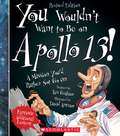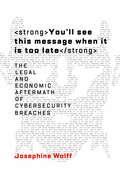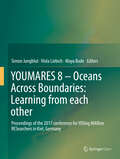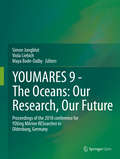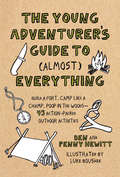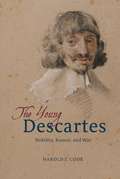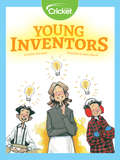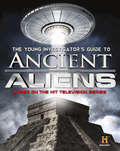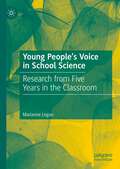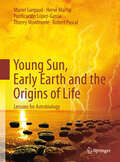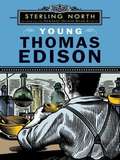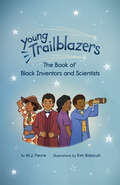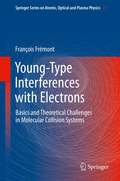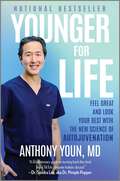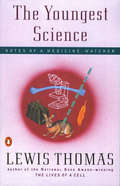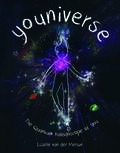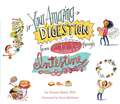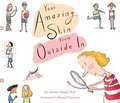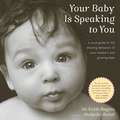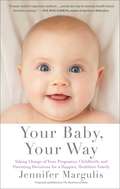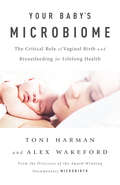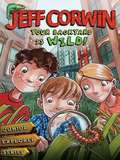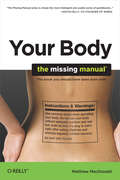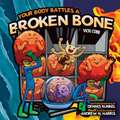- Table View
- List View
You Wouldn't Want to Be on Apollo 13!: A Mission You'd Rather Not Go On (You Wouldn't Want To... Series)
by Ian GrahamCount down to liftoff! You are about to go on the most exciting and dangerous journey of your life. You are part of the crew on the spacecraft Apollo 13. It's Amazing! Top Tips from Experts! If you need to meets, do it before your helmet is fitted! Make sure you ate tightly strapped into your seal for takeoff. Don't panic! Keep calm or you might make things worse. Don't move around too much-you'll use up more precious oxygen.
You'll See This Message When It Is Too Late: The Legal and Economic Aftermath of Cybersecurity Breaches (Information Policy)
by Josephine WolffWhat we can learn from the aftermath of cybersecurity breaches and how we can do a better job protecting online data. Cybersecurity incidents make the news with startling regularity. Each breach—the theft of 145.5 million Americans' information from Equifax, for example, or the Russian government's theft of National Security Agency documents, or the Sony Pictures data dump—makes headlines, inspires panic, instigates lawsuits, and is then forgotten. The cycle of alarm and amnesia continues with the next attack, and the one after that. In this book, cybersecurity expert Josephine Wolff argues that we shouldn't forget about these incidents, we should investigate their trajectory, from technology flaws to reparations for harm done to their impact on future security measures. We can learn valuable lessons in the aftermath of cybersecurity breaches. Wolff describes a series of significant cybersecurity incidents between 2005 and 2015, mapping the entire life cycle of each breach in order to identify opportunities for defensive intervention. She outlines three types of motives underlying these attacks—financial gain, espionage, and public humiliation of the victims—that have remained consistent through a decade of cyberattacks, offers examples of each, and analyzes the emergence of different attack patterns. The enormous TJX breach in 2006, for instance, set the pattern for a series of payment card fraud incidents that led to identity fraud and extortion; the Chinese army conducted cyberespionage campaigns directed at U.S.-based companies from 2006 to 2014, sparking debate about the distinction between economic and political espionage; and the 2014 breach of the Ashley Madison website was aimed at reputations rather than bank accounts.
YOUMARES 8 – Oceans Across Boundaries: Proceedings Of The 2017 Conference For Young Marine Researchers In Kiel, Germany
by Maya Bode Viola Liebich Simon JungblutThis open access book presents the proceedings volume of the YOUMARES 8 conference, which took place in Kiel, Germany, in September 2017, supported by the German Association for Marine Sciences (DGM). The YOUMARES conference series is entirely bottom-up organized by and for YOUng MARine RESearchers. Qualified early career scientists moderated the scientific sessions during the conference and provided literature reviews on aspects of their research field. These reviews and the presenters’ conference abstracts are compiled here. Thus, this book discusses highly topical fields of marine research and aims to act as a source of knowledge and inspiration for further reading and research.
YOUMARES 9 - The Oceans: Proceedings of the 2018 conference for YOUng MArine RESearcher in Oldenburg, Germany
by Simon Jungblut Viola Liebich Maya Bode-DalbyThis open access book summarizes peer-reviewed articles and the abstracts of oral and poster presentations given during the YOUMARES 9 conference which took place in Oldenburg, Germany, in September 2018. The aims of this book are to summarize state-of-the-art knowledge in marine sciences and to inspire scientists of all career stages in the development of further research. These conferences are organized by and for young marine researchers. Qualified early-career researchers, who moderated topical sessions during the conference, contributed literature reviews on specific topics within their research field.
The Young Adventurer's Guide to (Almost) Everything: Build a Fort, Camp Like a Champ, Poop in the Woods-45 Action-Packed Outdoor Activities
by Ben Hewitt45 step-by-step, illustrated activties that teach kids everything from how to see like an owl to build the world's coolest fort from sticks. (ages 8-12)Calling all adventurers! Want to know how to build a fort from nothing but sticks? Or find your way through the forest? This survival guide is your ticket to getting down and dirty in nature and learning to make the coolest things with your own two hands. Look inside to learn how to: • Use a knife without bleeding • Sleep in the woods without freezing • Escape a bear without getting eaten • Poop in the woods without falling down • Find your way home without a GPS • Eat bugs without throwing up • And so much more!
The Young Descartes: Nobility, Rumor, and War
by Harold J. CookRené Descartes is best known as the man who coined the phrase “I think, therefore I am.” But though he is remembered most as a thinker, Descartes, the man, was no disembodied mind, theorizing at great remove from the worldly affairs and concerns of his time. Far from it. As a young nobleman, Descartes was a soldier and courtier who took part in some of the greatest events of his generation—a man who would not seem out of place in the pages of The Three Musketeers. In The Young Descartes, Harold J. Cook tells the story of a man who did not set out to become an author or philosopher—Descartes began publishing only after the age of forty. Rather, for years he traveled throughout Europe in diplomacy and at war. He was present at the opening events of the Thirty Years' War in Central Europe and Northern Italy, and was also later involved in struggles within France. Enduring exile, scandals, and courtly intrigue, on his journeys Descartes associated with many of the most innovative free thinkers and poets of his day, as well as great noblemen, noblewomen, and charismatic religious reformers. In his personal life, he expressed love for men as well as women and was accused of libertinism by his adversaries. These early years on the move, in touch with powerful people and great events, and his experiences with military engineering and philosophical materialism all shaped the thinker and philosopher Descartes became in exile, where he would begin to write and publish, with purpose. But though it is these writings that made ultimately made him famous, The Young Descartes shows that this story of his early life and the tumultuous times that molded him is sure to spark a reappraisal of his philosophy and legacy.
Young Inventors
by Kathie MacIsaacKids have always had amazing ideas, like how to keep your ears warm on a cold winter day or an icy treat to enjoy on a hot summer day. Learn about four young inventors and their inventions that helped to change people's lives.
The Young Investigator's Guide to Ancient Aliens
by History ChannelAs a tie-in to the wildly successful History Channel show, here's a book filled with fascinating tales, ancient folklore, and compelling evidence of the role extraterrestrials may have played in human history. What really happened to the dinosaurs? Who actually built the ancient pyramids in Egypt? Are airplanes really as modern as we think they are? This book takes a close look at landmark events throughout history and asks the question: What if aliens were involved? Spanning history, from the earliest of human civilizations to the modern period, this book exposes evidence of the presence of extraterrestrials in some of our most triumphant and devastating moments.
Young People’s Voice in School Science: Research from Five Years in the Classroom
by Marianne LoganThis book highlights young people’s changing attitudes toward and interest in science over the course of a five-year longitudinal study. Utilizing a mixed-methods approach, the author presents rich data from children and young people, as well as their parents and teachers. By providing a glimpse of science pedagogy from the perspective of young people and those who work with them, the book identifies factors that affect students' interest in science throughout their primary and secondary education. The book also examines a posthumanist philosophical approach to science education and emphasizes the interrelationship of all things within the context of science education.
Young Sun, Early Earth and the Origins of Life
by Hervé Martin Muriel Gargaud Purificación López-García Robert Pascal Storm Dunlop Thierry Montmerle- How did the Sun come into existence? - How was the Earth formed? - How long has Earth been the way it is now, with its combination of oceans and continents? - How do you define "life"? - How did the first life forms emerge? - What conditions made it possible for living things to evolve? All these questions are answered in this colourful textbook addressing undergraduate students in "Origins of Life" courses and the scientifically interested public. The authors take the reader on an amazing voyage through time, beginning five thousand million years ago in a cloud of interstellar dust and ending five hundred million years ago, when the living world that we see today was finally formed. A chapter on exoplanets provides an overview of the search for planets outside the solar system, especially for habitable ones. The appendix closes the book with a glossary, a bibliography of further readings and a summary of the Origins of the Earth and life in fourteen boxes.
Young Thomas Edison
by Sterling NorthUnable to hear, Thomas Edison seemed unlikely to become one of America?s greatest inventors, but as a hardworking young man, he wasn?t about to let a minor obstacle stop him. He invented the phonograph, the incandescent lightbulb, and motion pictures, to name but three of his many important inventions. Eventually he was named ?the greatest living American. ? Follow Thomas Edison?s life from losing his sense of hearing to losing his hard-earned fortune, in this intriguing biography by Newbery Honor author Sterling North. .
Young Trailblazers: The Book of Black Inventors and Scientists
by M. J. FievreDiscover Incredible Inventions by Black People (Ages 8-12) #1 New Release in Children's Inventors Books Young Trailblazers: The Book of Black Inventors and Scientists is a fun new book for children that teaches kids about inventions by Black people that have impacted the world through their ingenuity and trailblazing innovation. From Black Inventors to Black Scientists. Take your child on an adventure and travel through time to meet famous black inventors who changed the game. Countdown to liftoff with Katherine Johnson, who helped pioneer U.S. crewed space missions. Safely cross the street with Garrett Morgan, who invented the traffic signal—or even sing your heart out with James West&’s invention of the microphone. All of these inventions by Black people have, in one way or another, shaped the past and present through trailblazing creativity and resilience; these stories are sure to inspire every child. Experience an array of rich Black history. In this book, there are Black scientists and Black inventors we all know, such as Lewis Howard Latimer and Sarah Boone. There are also dozens of Black trailblazers that we don&’t, all of whom have accomplished remarkable things in literature, entertainment, education, STEM, business, military and government services, politics and law, activism, sports, spirituality, and more. Inside this book of inventions by Black people, you&’ll find: A fun and engaging introduction to Black inventors for kids Essential Black history for kids to learn about Interesting fun facts and beautiful illustrations If you enjoyed Black Women in Science, Black Inventors, or Black Heroes, then you&’ll love Young Trailblazers.
Young-Type Interferences with Electrons: Basics and Theoretical Challenges in Molecular Collision Systems
by François FrémontSince the discovery that atomic-size particles can be described as waves, many interference experiments have been realized with electrons to demonstrate their wave behavior. In this book, after describing the different steps that led to the present knowledge, we focus on the strong link existing between photon and electron interferences, highlighting the similarities and the differences. For example, the atomic centers of a hydrogen molecule are used to mimic the slits in the Young's famous interference experiment with light. We show, however, that the basic time-dependent ionization theories that describe these Young-type electron interferences are not able to reproduce the experiment. This crucial point remains a real challenge for theoreticians in atomic collision physics.
Younger for Life: Feel Great and Look Your Best with the New Science of Autojuvenation
by Anthony YounA NATIONAL BESTSELLERFrom bestselling author and beloved social media star Dr. Anthony Youn comes a revolutionary step-by-step guide to reversing the effects of aging at any stage in lifeGrowing older is a blessing. But the slow decline and the loss of functionality associated with aging has led us to treat the process like a disease. These negative effects of aging, however, are not inevitable. Rather, they&’re largely the result of environmental and lifestyle factors that, when properly addressed, can be reversed through a process called Autojuvenation™.Dr. Youn, one of America&’s most trusted surgeons, offers a groundbreaking new approach to turning back the clock naturally. In this step-by-step guide, he shows us how, through simple changes in diet, activity and skin care, we can look younger than ever before. Readers will learn: How to reverse the aging process by combining intermittent fasting with autojuvenation-promoting foods How to develop a simple skin care routine to look younger for life Best practices for sleep hygiene, yoga, exercise, mindset and natural dental care Everything you ever wanted to know about Botox, fillers, microneedling, chemical peels, fat-blasting treatments and more A simple three-week program to jump-start the autojuvenation process to look and feel your bestPacked with accessible, innovative tips and techniques, this must-read guide shows us the simple changes you can make to live longer, look better, stay healthier and feel amazing—for life.
The Youngest Science: Notes of a Medicine-Watcher
by Lewis ThomasFrom the 1920s when he watched his father, a general practitioner who made housecalls and wrote his prescriptions in Latin, to his days in medical school and beyond, Lewis Thomas saw medicine evolve from an art into a sophisticated science. The Youngest Science is Dr. Thomas's account of his life in the medical profession and an inquiry into what medicine is all about--the youngest science, but one rich in possibility and promise.He chronicles his training in Boston and New York, his war career in the South Pacific, his most impassioned research projects, his work as an administrator in hospitals and medical schools, and even his experiences as a patient. Along the way, Thomas explores the complex relationships between research and practice, between words and meanings, between human error and human accomplishment, More than a magnificent autobiography, The Youngest Science is also a celebration and a warning--about the nature of medicine and about the future life of our planet.
Youniverse: The Quantum Kaleidoscope Of You
by Lizelle van der MerweThis nonfiction picture book, by a South African writer, explores how light weaves the universe together and how much we have in common with a quivering aspen leaf and the dust of a distant nebula. Youniverse aims to inspire a reverence for our fragile blue planet voyaging through space. The lyrical text and simple, childlike illustrations linger on one object at a time, building a mind-liberating journey from electrons and photos through atoms, molecules, cells, and the human body; outward to the solar system, the Milky Way, and the universe; and backward to the beginning of time in the Big Bang. Light weaves through the pages as it weaves the universe together, showing us that we have almost everything in common with a quivering aspen leaf and the dust of a distant nebula. “Your imagination is the greatest of miracles,” van der Merwe writes, “a consciousness that contemplates the atoms and the stars from which it was made.” A child sees a world in a tidepool and an enchanted forest in a copse of trees. Songbirds speak messages. Moonlight whispers through an open window. The inner and outer worlds flow together without boundaries. Does growing up have to mean leaving that magic kingdom behind? Lizelle van der Merwe believes that a child’s sense of wonder should instead be encouraged, expanded, and immortalized with the real-life magic of science. The more we know about the quantum worlds within and outside us, the more wisdom is evident in a child’s view of the world.
Your Amazing Digestion from Mouth through Intestine (Your Amazing Body Books)
by Joanne SettelDr. Joanne Settel has all the answers to our most burning questions in this wacky and informative book of poems about our digestive systems. Have you ever wondered… Why spicy foods can make you sweat? Why garlic makes your breath so stinky? Just how long your long intestine is? What a pizza slice looks like…going down? Why food tastes different when you have a cold? With fascinating details, catchy rhymes, and quirky illustrations by Steve Björkman, acclaimed author Joanne Settel answers all of these questions (and more!) in this engrossing, fun exploration of the science of our digestive systems. When she’s through, you won’t believe what your guts can do—or what you can stomach!
Your Amazing Skin from Outside In (Your Amazing Body Books)
by Bonnie Timmons Joanne SettelIt’s itchy, it’s sweaty, it’s embarrassing...but most of all, it’s fascinating! Dr. Joanne Settel has all the answers to our most burning questions in this wacky and informative book of poems about our skin.Have you ever wondered… Why you blush when you’re embarrassed? Why you’ve got freckles everywhere? Why your fingers wrinkle in the pool? Why your friends come in all different colors? Why mosquitoes think you’re delicious? Why you’ve got that giant pimple on your nose? Look no further! With supercool facts, clever rhymes, and hilarious illustrations by Bonnie Timmons, acclaimed author Joanne Settel answers all these questions (and more!) in this fascinating, fun exploration of the science of our skin from head to toe. When she’s through, you won’t believe what your skin can do!
Your Baby Is Speaking to You
by Abelardo Morell Kevin NugentFrom an international expert on infant-parent communication, Your Baby Is Speaking To You is destined to become a parenting classic. Through intimate access to babies and their families, Dr. Kevin Nugent and acclaimed photographer Abelardo Morell capture the amazingly precocious communications strategies babies demonstrate from the moment they are born. Your Baby Is Speaking to You illustrates the full range of behaviors--early smiling to startling, feeding to sleeping, listening to your voice and recognizing your face. The newest research--including information on subtle and fleeting behaviors not seen or explained in any other book--illuminates the meaning of the things babies do that concern and delight new parents: - the language of yawning - the rich range of cries, and how to understand their meanings - baby's earliest "sleep smiles" and sleep states, and what they signify Your Baby Is Speaking To You delivers the information parents crave in gentle, accessible style while giving parents the confidence they need to respond to their own baby's way of communicating during the very first astonishing days and the months beyond.
Your Baby, Your Way
by Jennifer MargulisWhy, despite our state-of-the-art medical technology, does the United States have among the highest maternal and infant mortality rates in the industrialized world? Why do pregnant women who are planning to breastfeed receive "free" samples of infant formula from American obstetricians? Why are American newborns given a vaccine at birth against hepatitis B, a sexually transmitted disease? The Business of Baby, an eye-opening work of investigative journalism, exposes how our current cultural practices during pregnancy, childbirth, and the first year of a baby's life are not based on the best evidence or the most modern science, revealing how American moms and their babies are being undermined by corporate interests. An illuminating combination of meticulous research and in-depth interviews with parents, doctors, midwives, nurses, health care administrators, and scientists, Margulis's impassioned and eloquent critique is shocking, groundbreaking, and revelatory. The Business of Baby arms parents with the information they need to make informed decisions about their own health and the health of their infants.
Your Baby, Your Way: Taking Charge of your Pregnancy, Childbirth, and Parenting Decisions for a Happier, Healthier Family
by Jennifer MargulisWhy, despite our state-of-the-art medical technology, does the United States have among the highest maternal and infant mortality rates in the industrialized world? Why do pregnant women who are planning to breastfeed receive "free" samples of infant formula from American obstetricians? Why are American newborns given a vaccine at birth against hepatitis B, a sexually transmitted disease? The Business of Baby, an eye-opening work of investigative journalism, exposes how our current cultural practices during pregnancy, childbirth, and the first year of a baby's life are not based on the best evidence or the most modern science, revealing how American moms and their babies are being undermined by corporate interests. An illuminating combination of meticulous research and in-depth interviews with parents, doctors, midwives, nurses, health care administrators, and scientists, Margulis's impassioned and eloquent critique is shocking, groundbreaking, and revelatory. The Business of Baby arms parents with the information they need to make informed decisions about their own health and the health of their infants.
Your Baby's Microbiome: The Critical Role of Vaginal Birth and Breastfeeding for Lifelong Health
by Toni Harman Alex WakefordFrom the Directors of the Award-Winning Documentary Microbirth At least two amazing events happen during childbirth. There’s the obvious main event, which is the emergence of a new human into the world. But there’s another event taking place simultaneously, a crucial event that is not visible to the naked eye, an event that could determine the lifelong health of the baby. This is the seeding of the baby’s microbiome, the community of “good” bacteria that we carry with us throughout our lives. The seeding of the microbiome, along with breastfeeding and skin-to-skin contact, kick-starts the baby’s immune system and helps protect the infant from disease across a lifetime. Researchers are discovering, however, that interventions such as the use of synthetic oxytocin, antibiotics, C-sections, and formula feeding interfere with, or bypass completely, the microbial transfer from mother to baby. These bacteria are vital for human health, and science has linked an imbalance in the human microbiome with multiple chronic diseases. Drawing on the extensive research they carried out for their documentary film Microbirth, authors Toni Harman and Alex Wakeford reveal a fascinating new view of birth and how microscopic happenings can have lifelong consequences, for ourselves, our children—and our species as a whole.
Your Backyard Is Wild
by Jeff CorwinA backyard anywhere is always fun to explore! When budding naturalists Lucy and Benjamin get a chance to visit their cousin Gabe in Brooklyn, they can't wait. They are used to seeing fascinating animals and plants in the Florida Everglades where they live, but they can't imagine what they will find in Gabe's New York City backyard. The first book in Jeff Corwin's young middle-grade fiction series shows kids that no matter where you live, you can have fun discovering the plants, animals, and natural life around you. .
Your Body: The Missing Manual
by Matthew MacdonaldWhat, exactly, do you know about your body? Do you know how your immune system works? Or what your pancreas does? Or the myriad -- and often simple -- ways you can improve the way your body functions? This full-color, visually rich guide answers these questions and more. Matthew MacDonald, noted author of Your Brain: The Missing Manual, takes you on a fascinating tour of your body from the outside in, beginning with your skin and progressing to your vital organs. You'll look at the quirks, curiosities, and shortcomings we've all learned to live with, and pick up just enough biology to understand how your body works. You'll learn: That you shed skin more frequently than snakes do Why the number of fat cells you have rarely changes, no matter how much you diet or exercise -- they simply get bigger or smaller How you can measure and control fat That your hair is made from the same stuff as horses' hooves That you use only a small amount of the oxygen you inhale Why blood pressure is a more important health measure than heart rate -- with four ways to lower dangerously high blood pressure Why our bodies crave foods that make us fat How to use heart rate to shape an optimal workout session -- one that's neither too easy nor too strenuous Why a tongue with just half a dozen taste buds can identify thousands of flavors Why bacteria in your gut outnumbers cells in your body -- and what function they serve Why we age, and why we can't turn back the clock What happens to your body in the minutes after you die Rather than dumbed-down self-help or dense medical text, Your Body: The Missing Manual is entertaining and packed with information you can use. It's a book that may well change your life.Reader comments for Your Brain: The Missing Manual, also by author Matthew MacDonald: "Popular books on the brain are often minefields of attractive but inaccurate information. This one manages to avoid most of the hype and easy faulty generalizations while providing easy to read and digest information about the brain. It has useful tricks without the breathless hype of many popular books." -- Elizabeth Zwicky, The Usenix Magazine "...a unique guide that should be sought after by any who want to maximize what they can accomplish with their mental abilities and resources." -- James A. Cox, The Midwest Book Review - Wisconsin Bookwatch "If you can't figure out how to use your brain after reading this guide, you may want to return your brain for another." -- The Sacramento Book Review, Volume 1, Issue 2, Page 19 "It's rare to find a book on any technical subject that is as well written and readable as Your Brain: The Missing Manual. The book covers pretty much anything you may want to know about your brain, from what makes it up, through how it develops to how to mitigate the affects of aging. The book is easy reading, fact packed and highlighted notes and practical applications. So if you want to learn more about your brain, how it works, how to get the best out of it or just want to stave off the ravages of Alzheimers (see chapter ten for details of how learning helps maintain your brain) then I can't recommend this book highly enough." -- Neil Davis, Amazon.co.uk "MacDonald's writing style is perfect for this kind of guide. It remains educational without becoming overly technical or using unexplained jargon. And even though the book covers a broad scope of topics, MacDonald keeps it well organized and easy to follow. The book captures your attention with fun facts and interesting studies that any person could apply to their own understanding of human ability. It has great descriptions of the brain and its interconnected parts, as well as providing full color pictures and diagrams to offer a better explanation of what the author is talking about." -- Janica Unruh, Blogcritics Magazine
Your Body Battles a Broken Bone
by Vicki CobbBreaking a bone hurts! But did you know that it's the start of a battle for your body to heal itself? That ache happens because damaged nerve cells send out a cry for help. In response, red blood cells rush in to bring oxygen and nutrients. White blood cells clean up the dead bone and muscle cells. Blood also brings fibroblast cells. They build a sort of scaffolding around the break so that new bone will fill in. And stem cells arrive to transform themselves into cells that will make brand-new bone. The whole area becomes an active construction site as your body battles the damage and heals itself. Get a close look at this body battle with comic illustrations and ground-breaking photomicrographs. The photomicrographs magnify the actual cellular processes tens of thousands of times, offering you a front-row seat for all the action.
